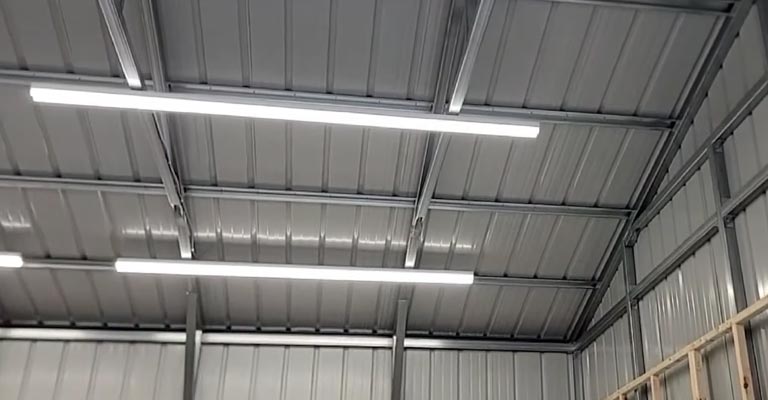Stepping into a well-lit workshop can be a transformative experience. The right lighting not only enhances visibility but also sets the tone for productivity and creativity.
Whether you’re a DIY enthusiast, a craftsman, or an artist, the illumination in your workspace plays a pivotal role in the quality of your output.
One common question that arises when designing a workshop is: How many lumens does a 30×40 shop need?
For a space of 1200 square feet, you’d need approximately 120,000 lumens. This translates to about 46 T8 32W tubes or 12 fixtures with 4 tubes each. The average luminosity for a 32W T8 tube is around 2600 lumens.
While there’s no one-size-fits-all answer, understanding the relationship between lumens, space dimensions, and intended activities can help you create a workspace that’s both functional and visually appealing.
How Many Lumens Is A 30×40 Shop?
The term “lumens” refers to the measurement of light output or brightness, typically used for light bulbs, fixtures, or sources of illumination.
A shop’s lighting needs can vary based on factors such as the type of work being done, the layout of the space, and personal preferences for lighting intensity.
To determine the appropriate number of lumens for a 30×40 shop, you would need to consider the desired level of brightness. However, there are some general recommendations for commercial spaces like workshops.
For a workshop, a common guideline is to have around 50-75 lumens per square foot. A 30×40 shop has an area of 1200 square feet (30 * 40 = 1200), so using the guideline of 50-75 lumens per square foot:
Minimum lumens: 50 lumens/sq ft * 1200 sq ft = 60,000 lumens
Maximum lumens: 75 lumens/sq ft * 1200 sq ft = 90,000 lumens
So, you would ideally need lighting that provides between 60,000 to 90,000 lumens for a 30×40 shop, based on the general guideline.
Keep in mind that this is a rough estimate and actual lighting needs might vary based on your specific requirements and preferences.
It’s a good idea to consult with a lighting professional or use a lighting calculator to determine the best lighting setup for your workshop.
Lumens Calculation Per Square Foot
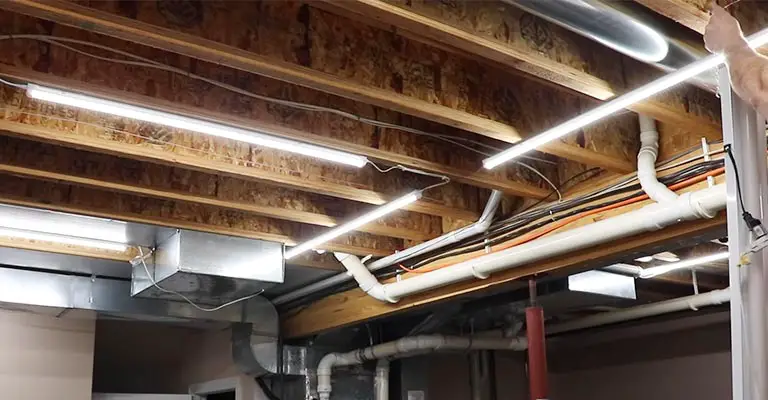
Calculating the recommended lumens per square foot involves considering the type of activity you’ll be performing in the space.
Different tasks require varying levels of lighting to ensure optimal visibility and comfort. Here’s a breakdown of the general recommended lumens per square foot for different types of activities:
- General Lighting: This level of lighting provides basic illumination for moving around and performing everyday tasks. It’s suitable for areas where detailed work isn’t a priority.
Recommended Lumens: 20-50 lumens per square foot - Task Lighting: Task lighting is designed to illuminate specific work areas where you need to focus on details. It’s ideal for activities like reading, crafting, or using a workbench.
Recommended Lumens: 50-75 lumens per square foot - Detailed Work and Specialized Tasks: For activities that require high precision and attention to detail, such as electronics assembly or fine art, you’ll need more intense lighting.
Recommended Lumens: 75-100+ lumens per square foot
Keep in mind that these recommendations provide a range to help you determine the right level of lighting for your specific needs. You should consider both the nature of the work you’ll be doing and your personal comfort preferences.
To calculate the lumens required for your specific area, follow these steps:
- Measure the length and width of the area in feet to determine the square footage.
- Decide on the type of activity you’ll be performing in that area (general lighting, task lighting, or detailed work).
- Use the appropriate range of recommended lumens per square foot for that activity.
- Multiply the square footage by the recommended lumens per square foot to get the total lumens needed.
For example, if you have a 10×12 room where you’ll be doing detailed work and want to use 90 lumens per square foot:
- Area = 10 ft * 12 ft = 120 sq ft
- Activity = Detailed work (90 lumens/sq ft)
- Total Lumens = 120 sq ft * 90 lumens/sq ft = 10,800 lumens
In this scenario, you would need around 10,800 lumens to adequately light your 10×12 room for detailed work.
How Many Lights For A 30×40 Shop?
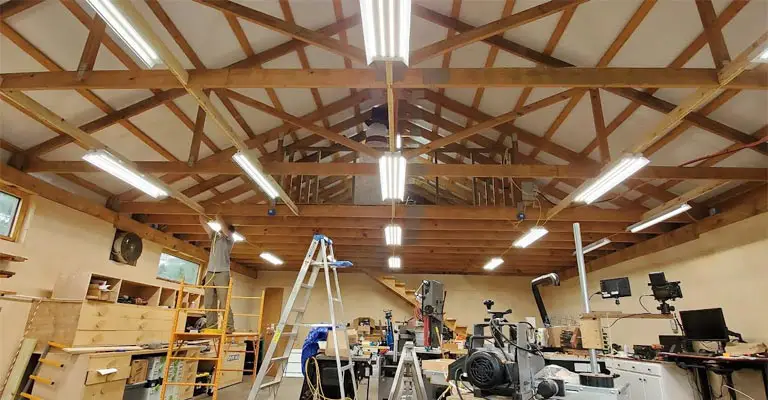
Before calculating the exact number of lights, it’s essential to understand the factors that influence your workshop’s lighting requirements:
- Workshop Activities: The type of work you intend to carry out significantly impacts your lighting needs. Tasks that require fine detail work, such as intricate soldering or painting, demand higher levels of illumination.
- Light Placement: The strategic placement of lights plays a vital role. Shadows can hamper visibility and lead to eye strain. Evenly distributed lights reduce shadow formation and create a well-lit environment.
- Ceiling Height: The height of your shop’s ceiling affects how light spreads. Taller ceilings might require more powerful lights to ensure uniform brightness across the entire space.
- Light Intensity: Different lighting fixtures emit varying levels of brightness. LED lights, for instance, provide energy-efficient and high-lumen output, making them a popular choice for workshops.
Calculating Lighting Needs
As a general guideline, aiming for 50 to 75 lumens per square foot is a good starting point. For your 30×40 shop:
- Minimum lumens: 50 lumens/sq ft * 1200 sq ft = 60,000 lumens
- Maximum lumens: 75 lumens/sq ft * 1200 sq ft = 90,000 lumens
This range gives you an idea of the total luminosity required to adequately light your shop.
Choosing the Right Lights
Selecting the appropriate lighting fixtures is equally crucial. Consider these options:
- Overhead LED Panels: These provide uniform illumination and can be spaced out to cover the entire shop effectively.
- Task Lighting: For specific workstations, task lights like adjustable LED desk lamps offer focused brightness where it’s needed most.
- Shop Lights: Hanging fluorescent or LED shop lights are versatile choices that cover large areas with ease.
Calculation Of Lumens Required For Your Shop
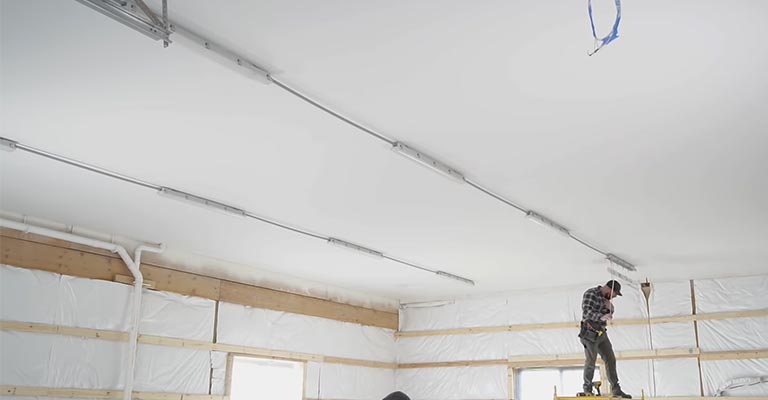
Calculating the lumens required for your shop involves considering the total square footage of the space and the recommended lumens per square foot based on the type of activities you’ll be conducting. The formula is simple:
Total Lumens = Area in square feet × Recommended lumens per square foot
Let’s break down the calculation step by step:
- Determine the Area of Your Shop: Measure the length and width of your shop to calculate the total square footage. For example, if your shop is 30 feet wide and 40 feet long, the area would be 30 * 40 = 1200 square feet.
- Select the Recommended Lumens per Square Foot: The recommended lumens per square foot can vary based on the type of work you’ll be doing. As a general guideline:
- General lighting: 20-50 lumens/sq ft
- Task-specific lighting: 50-75 lumens/sq ft
- Detailed work (e.g., precision craftsmanship): 75-100+ lumens/sq ft
Choose a value that aligns with your workshop’s activities. For example, let’s assume you want to provide task-specific lighting, and you opt for 60 lumens per square foot.
- Perform the Calculation: Using the formula mentioned earlier:
Total Lumens = Area × Recommended lumens per square foot Total Lumens = 1200 sq ft × 60 lumens/sq ft Total Lumens = 72,000 lumens
In this example, you would require a total of 72,000 lumens to adequately light your 30×40 shop with task-specific lighting.
Remember that this calculation provides a starting point, and individual preferences may vary.
You might want to adjust the lumens based on factors such as the shop’s layout, the height of the ceiling, and any specialized lighting needs you have.
Additionally, consider the types of lighting fixtures you plan to use. Different fixtures have different lumen outputs, so ensure that the fixtures you choose collectively provide the total lumens you’ve calculated.
If you’re using LED lights, they often provide higher lumens per watt, making them energy-efficient options for well-lit workshops.
The Importance of Proper Lighting
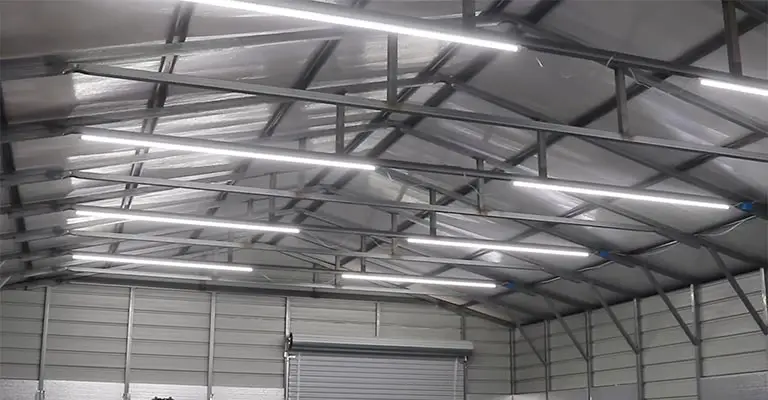
Imagine stepping into a workshop where every tool, material, and project is illuminated to perfection. The difference it makes to your efficiency, focus, and overall experience is undeniable.
Proper lighting not only enhances visibility but also influences mood and concentration.
Whether you’re crafting, repairing, or designing, having an environment that optimally balances light intensity and quality can significantly impact your outcomes.
1. Accent Lighting: Illuminating Detail and Focus
Accent lighting is the art of directing light to highlight specific points of interest. In a workshop, it’s akin to casting a spotlight on your masterpiece.
Whether it’s a delicate piece of woodworking, an intricately designed component, or a finely painted detail, accent lighting ensures that every nuance is showcased in its full glory.
By creating visual hierarchy, this technique draws the eye precisely where you want it, adding depth and drama to your workspace.
2. Ambient Lighting: Setting the Mood and Tone
Ambient lighting forms the backbone of a well-lit space. It provides overall illumination, eliminating harsh shadows and creating a comfortable atmosphere.
In a workshop, ambient lighting ensures that you can navigate the area without strain and helps establish the overall mood of the space.
Whether it’s warm and inviting or bright and energetic, ambient lighting sets the stage for all other lighting techniques to shine.
3. High Activity Illumination: Shining a Light on Productivity
In areas where the bulk of your work takes place, high activity illumination is paramount. This lighting is intense and focused, designed to eliminate shadows and ensure clear visibility.
Whether you’re soldering delicate electronics, crafting intricate jewelry, or meticulously painting, high activity lighting ensures you can work with precision and accuracy. It minimizes eye strain and supports you during those intensive work sessions.
4. Shelf and Case Lighting: Showcasing Your Creations
Your workshop isn’t just a place for creating; it’s also a gallery of your accomplishments. Shelf and case lighting transform your storage spaces into displays of pride.
Whether it’s a shelf lined with meticulously organized tools or a display case housing your most prized creations, these lighting techniques add an exhibition-worthy flair to your workspace.
Conclusion
In conclusion, determining the ideal number of lumens for a 30×40 shop involves thoughtful consideration of various factors.
From the nature of your work to the layout of the space, your lighting requirements are as unique as the creations that will take shape within those walls.
While a general guideline suggests aiming for 50-75 lumens per square foot, this range is not set in stone. It serves as a starting point, which can be tailored to match your specific needs.
The type of activities you’ll engage in, the level of detail required, and your personal comfort all play a role in shaping the lighting solution that suits you best.
Ultimately, the goal of determining lumens is to create an environment that fosters productivity, creativity, and comfort.

